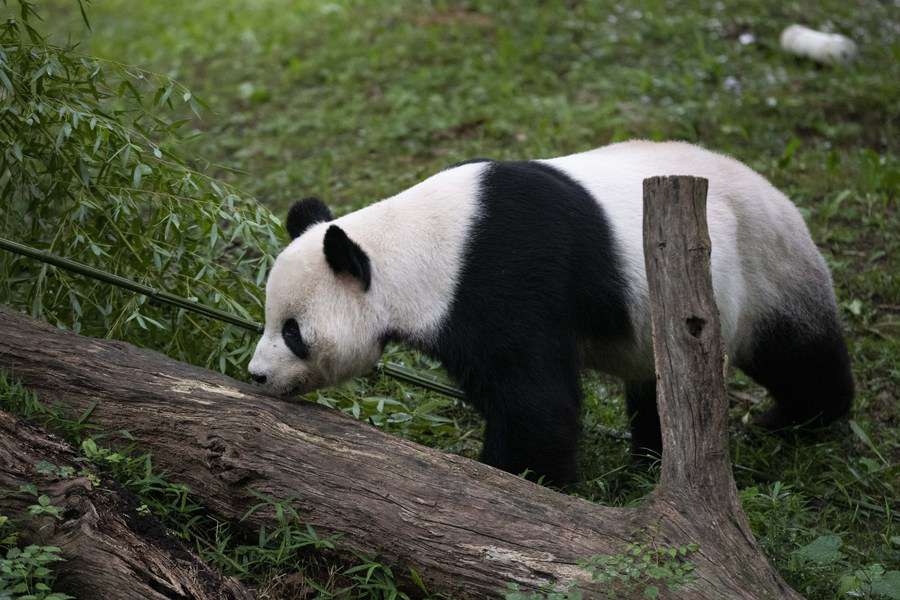


Giant panda Tian Tian is seen at the Smithsonian's National Zoo in Washington, D.C., the United States, Aug. 22, 2020. Mei Xiang was artificially inseminated in March this year with frozen semen collected from Tian Tian. (Xinhua/Liu Jie)
Giant pandas, an exemplar of the decades-old partnership between U.S. and Chinese institutes in conserving species, will prolong their residence here through the end of 2023, a delight to scientists as it enables further strides in research.
WASHINGTON, Dec. 8 (Xinhua) -- The Smithsonian's National Zoo and the China Wildlife Conservation Association have extended their giant panda research agreement for three years, the zoo announced Monday.
Giant pandas, an exemplar of the decades-old partnership between U.S. and Chinese institutes in conserving species, will prolong their residence here through the end of 2023, a delight to scientists as it enables further strides in research.
"Our long-standing collaboration with Chinese colleagues to study, care for and save the giant panda will now pass the half-century mark," said Steve Monfort, John and Adrienne Mars Director of the Smithsonian's National Zoo and Conservation Biology Institute, in a statement.
Earlier this year at the zoo, giant pandas Mei Xiang and Tian Tian gave birth to their cub Xiao Qi Ji, or "little miracle" in English.

Undated photo taken on November, 2020 shows the giant panda cub "Xiao Qi Ji" at Smithsonian's National Zoo in Washington, D.C., the United States. (Smithsonian's National Zoo/Handout via Xinhua)
"Through the power of science and cooperation, and with the support of the public and benefactors like David Rubenstein, our work on behalf of this beloved bear species continues," Monfort said. "Along with millions of Americans, I look forward to the next three years, watching Xiao Qi Ji grow and making further strides in conservation and in our understanding of giant pandas."
Rubenstein, a U.S. businessman and member of the Smithsonian Board of Regents, has pledged to continue funding the zoo's giant panda research and conservation program through the end of 2023, the statement added.
Conservation efforts supported in China, it detailed, include research on restoring giant panda habitat, monitoring wildlife diseases, assessing impacts of climate change, and supporting more conservation capacity-building programs.
"Giant pandas are an incredible species that still need our help," noted Rubenstein.
The zoo, part of the Smithsonian Institution, a U.S. museum and research complex, received its first pair of giant pandas in 1972 as a gift from the Chinese government. Study then started and continued there on giant pandas' biology, behavior, breeding, reproduction and diseases.

Giant Panda Mei Xiang eats treats in the giant panda house at the Smithsonian's National Zoo in Washington D.C., the United States, on Feb. 23, 2019. (Xinhua/Ting Shen)
Mei Xiang and Tian Tian, the zoo's second pair of giant pandas, have been living here since late 2000 and have given birth to four surviving cubs.
Much of what the zoo's animal care staff and scientists know about giant pandas' biology, behavior and reproduction -- knowledge shared with other institutions caring for and breeding the vulnerable species -- comes from caring for and studying Mei Xiang and Tian Tian over the past two decades, said the National Zoo.
As Xiao Qi Ji, a male, was born on Aug. 21, 22-year-old Mei Xiang became the oldest female giant panda to give birth in North America.
According to the zoo, the cub's name marks "the extraordinary circumstances under which he was born and celebrates the collaboration between colleagues who strive to conserve this species."

 Award-winning photos show poverty reduction achievements in NE China's Jilin province
Award-winning photos show poverty reduction achievements in NE China's Jilin province People dance to greet advent of New Year in Ameiqituo Town, Guizhou
People dance to greet advent of New Year in Ameiqituo Town, Guizhou Fire brigade in Shanghai holds group wedding
Fire brigade in Shanghai holds group wedding Tourists enjoy ice sculptures in Datan Town, north China
Tourists enjoy ice sculptures in Datan Town, north China Sunset scenery of Dayan Pagoda in Xi'an
Sunset scenery of Dayan Pagoda in Xi'an Tourists have fun at scenic spot in Nanlong Town, NW China
Tourists have fun at scenic spot in Nanlong Town, NW China Harbin attracts tourists by making best use of ice in winter
Harbin attracts tourists by making best use of ice in winter In pics: FIS Alpine Ski Women's World Cup Slalom
In pics: FIS Alpine Ski Women's World Cup Slalom Black-necked cranes rest at reservoir in Lhunzhub County, Lhasa
Black-necked cranes rest at reservoir in Lhunzhub County, Lhasa China's FAST telescope will be available to foreign scientists in April
China's FAST telescope will be available to foreign scientists in April